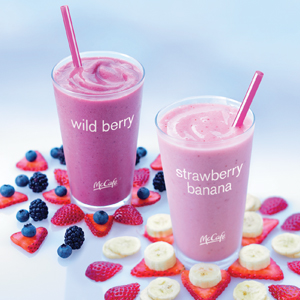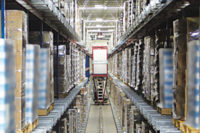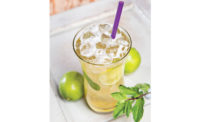
|
|
Last year, McDonald’s launched its McCafé real fruit smoothies in Strawberry Banana and Wild Berry flavors. |
As restaurant operators continue to recover from the effects of the recession, fast-casual restaurants have received positive marks from analysts. According to Chicago-based Technomic Inc.’s 2011 Top Fast-Casual Chain Restaurant Report, the foodservice segment outpaced the rest of the restaurant industry in 2010, with the top 100 chains growing 6 percent to nearly $18.9 billion.
The total units grew 3.9 percent, which was slower than last year, but faster than other dining segments, according to the report.
Darren Tristano, executive vice president at Technomic, says the food industry consulting firm predicts fast-casual restaurants will grow at a rate of 4.5 percent and continue to be strong in growth and expansion at a time when the rest of the industry is contracting. He says limited services and traditional quick services are at about 1.6 percent growth and behind that are fine dining, casual dining and mid-scale restaurants.
Technomic’s report found that fast-casual menus are differentiating themselves through adult beverages. Beer, wine and spirits are now available in nearly 40 percent of fast-casual chains with more room to grow, the report adds.
“Whether it’s in beer or spirit cocktails, I think one thing is constant when you ask consumers what they want to see more of on the menus they order from … it’s more variety and more choice,” says Mike Ginley, partner with NextLevel Marketing, Westport, Conn.
Ginley says craft beer has been driving growth in foodservice and he sees benefits to increased local offerings of wine varietals. But for cocktails, he says restaurants are seeing an explosion of flavor profiles, whether that includes superfruit flavors like pomegranate or acai, or sophisticated flavors, such as hibiscus or lavender.
But alcohol beverages are seeing another innovation taking place with “skinny” drinks, says Technomic’s Tristano.
“The idea of having low-calorie drinks where you’re having natural flavors, not just artificial, but the ability to maintain lower calories when you’re consuming adult beverages is very important — not unlike how light beer has been successful in the past,” he says.
Alcohol beverages are not the only category that has seen innovation. Dunkin’ Donuts added more frozen beverages to its portfolio with its Frozen Hot Chocolate. It delivers the same taste of Dunkin’ Donuts’ classic hot chocolate in an icy cold beverage, the company says. The company also collaborated with PepsiCo, Purchase, N.Y., earlier this year to develop and introduce the new Mountain Dew Coolatta — a frozen slush beverage that combines the lemon and lime citrus flavors of Mountain Dew and the format of the Dunkin’ Donuts Coolatta — at Dunkin’ Donuts restaurants. Both the Frozen Hot Chocolate and the Mountain Dew Coolatta are limited-time releases.
Tristano says smoothies also have become more popular, such as McDonald’s McCafé smoothies, which were launched last year in Strawberry Banana and Wild Berry varieties. The company recently introduced a Mango Pineapple Smoothie to the line as well. But the frozen beverage segment is one making a push this year.
“We’ve seen it started with milkshakes, evolved to smoothies, we’re now moving more into the iced beverages that are becoming much more popular,” he says.
Eric Giandelone, director of foodservice research with Mintel International, Chicago, says frozen beverages are going to be seasonal markets, but overall he has seen more emphasis on tea and coffee offerings.
“These are very margin-friendly offerings,” Giandelone says. “Tea and coffee traditionally have very high margins for restaurants, but when you get into some of the coffee beverages, if you go beyond straight-up coffee, the espresso-based drinks do command a fairly high price, so you’re also looking to build check averages, so you do see restaurants very interested in that aspect. It’s also a reaction to consumers shifting away from soda.”
Earlier this year, Unilever Food Solutions developed Lipton Fresh Brewed Sweet Teas, available in Sweet Tea, Southern Sweet Tea and Sweet Green Tea with Citrus. The teas are made from real tea leaves and have the sweetener and the flavor within each Lipton Tea Bag to eliminate the mixing and measuring of sugar or syrup, the company says. The zero-calorie varieties are designed to increase back-of-house efficiency while ensuring consistency with each glass of iced tea, it adds.
Giandelone says customization also is a trend taking place with beverages and foodservice such as with Starbucks’ customizable Frappuccino promotion as well as The Coca-Cola Co.’s Freestyle machine. It recently increased flavor options to 125 including Cherry Vanilla flavors for the Coca-Cola brand family as well as new Minute Maid Lemonade varieties.
Consumer appeal
In January, Mintel Oxygen Reports reported that
60 percent of U.S. restaurant-goers reported that the recession changed the way their family spent money. With consumers adjusting their behavior, analysts say restaurant operators have taken the same approach.
“In 2010, it’s one of those two different years within a year,” Mintel’s Giandelone says. “… The first half of the year was still very cautious about spending. I think the recession officially ended in 2009, but for consumers it didn’t really start to feel like it until the second half of 2010 when hiring started to pick up, so I do see a little bit of acceleration in sales and restaurant performances at the later half of 2010.”
NextLevel’s Ginley says that the marketing and promotions company found that in 2010, 68 percent of surveyed consumers were spending more or the same at full-service restaurants compared to 2009 when 70 percent of surveyed consumers said they were spending less.
“That’s the recovery that we’ve all been waiting for. [It’s] really showing signs that it could really, truly be here in 2011, and I think the stage was set for that in 2010,” he says.
Although the restaurant sector showed signs of recovery, establishments did so by finding new ways to draw in consumers.
“Restaurant operators have really had to react to a completely different consumer mindset today,” Ginley says. “While the recession is officially over, today’s consumers remain very financially cautious.”
Ginley says that although consumers might be frequenting restaurants, they also might be seeking less expensive restaurants or ordering less expensive items on menus. Appealing to cost-conscious consumers, promotions, specials and coupons are some ways restaurant operators have addressed the changed behavior, he adds.
“Today’s restaurants really had to react to that new consumer mindset by offering a variety of both meal and drink promotions, and we see that coupons — especially online coupons — have become increasingly popular,” Ginley says.
For drink promotions, Ginley says that Ruby Tuesday’s $5 price point of an entry-level cocktail has been a visibly successful promotion, where consumers can trade up to premium products for a nominal price. The restaurant chain recently added five new VeeV Acai Spirit signature cocktails to its menu: Watermelon Martini, Pomegranate Margarita, Skinny Pink Lemonade, Superfruit Cooler and Acai Mojito.
But when it comes to enticing consumers to frequent restaurants, operators have different avenues they can use.
“[It] really depends on what type of customer a restaurant’s trying to target,” Giandelone says. “If they’re looking to build check averages, chances are they’re going to be leading with those more expensive menu items that have a higher price tag. If they’re just looking to build traffic, then price promotions are going to be key for them, so both of them work well.”
Technomic’s Tristano, though, cautions that limited-time offers and other promotions might generate traffic, but are short-term solutions.
“It’s not going to help your margin when you’re basically driving them discounting,” he says. “That’s going to hurt the bottom line and ultimately impact the restaurant’s profitability.”
Healthier outlook
The National Restaurant Association (NRA), Washington, D.C., reported that the outlook for the restaurant industry remained positive in April based on the NRA’s Restaurant Performance Index (RPI), a monthly composite index that tracks the health and outlook of the U.S. restaurant industry.
The RPI is designed so the health of the restaurant channel is measured in relation to a steady state level of 100. April’s index stood at 100.9, which signifies industry expansion. April is the fifth consecutive month the RPI was above 100, the NRA reports.
For April, restaurant operators reported net positive same-store sales results, the NRA says. From April 2010 to April 2011, 50 percent of restaurant operators reported same-store sales gains, it adds.
Analysts are anticipating growth in the channel, however, they note that those numbers are tied to inflation.
“A big part of the performance is going to be the price increases,” says Technomic’s Tristano. “When you look at sales year over year and you look at the inflation of many prices, we expect that inflation to be somewhere around 3 percent. So as a whole, we believe the market’s going to grow a very small amount on a real basis — maybe a percent and a half. What we’ll probably see is more of a 4 percent growth, but a lot of that is going to be continued increases in menu prices.”
Although growth anticipation remains moderate, NextLevel’s Ginley says that select establishments can set themselves apart from the rest.
“The key is there’s pockets of growth to be had out there,” he says. “Double-digit growth by restaurants that have been able to differentiate in what has really become a sea of sameness. Everybody’s got the same type of food items on their menu and everyone’s atmosphere looks pretty much the same, so those who differentiate their offerings — whether it’s on their beverage side, on the food side or differentiate through their atmosphere — are going to be the ones who really rise out of this recovery the fastest.” BI




